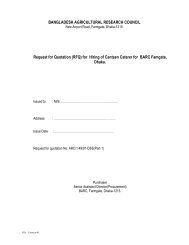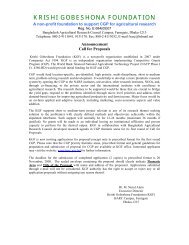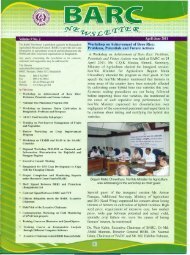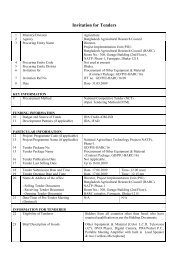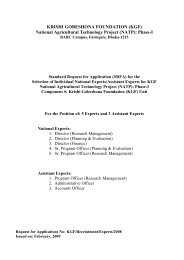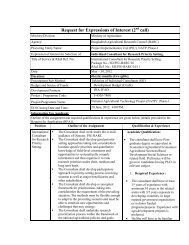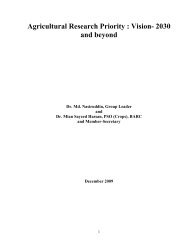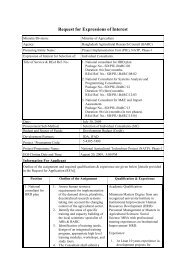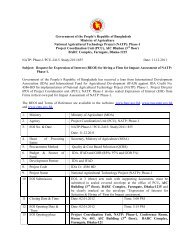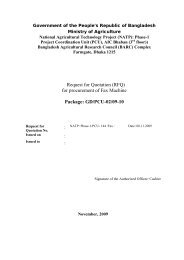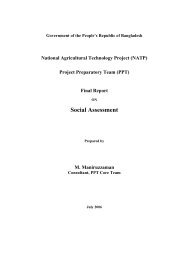ICT in Agriculture and Disaster Management - Bangladesh ...
ICT in Agriculture and Disaster Management - Bangladesh ...
ICT in Agriculture and Disaster Management - Bangladesh ...
You also want an ePaper? Increase the reach of your titles
YUMPU automatically turns print PDFs into web optimized ePapers that Google loves.
under base year situation (Table 7). In develop<strong>in</strong>g the National Program of Action for<br />
Adaptation to Climate Change (NAPA) of <strong>Bangladesh</strong>, the values for temperature <strong>and</strong><br />
precipitation change, <strong>and</strong> sea level rise for the year 2030, 2050 <strong>and</strong> 2100 were agreed<br />
upon by all six Sectoral Work<strong>in</strong>g Groups (Table 8). These climate change scenarios<br />
were used as the guid<strong>in</strong>g pr<strong>in</strong>ciple for formulat<strong>in</strong>g the NAPA.<br />
Table 7. The fluctuations of values of the parameters considered with respect to their values under<br />
base year situation<br />
Parameters<br />
2030 2075<br />
W<strong>in</strong>ter Monsoon W<strong>in</strong>ter Monsoon<br />
Temperature (° C) 2.00 0.65 3.00 1.50<br />
Evaporation (%) 10.00 2.00 16.00 5.00<br />
Precipitation (%) -3.00 11.00 -37.00 28.00<br />
Sea Level Rise (cm) 30.00 70.00<br />
Source: Ahmed <strong>and</strong> Alam (1999).<br />
Table 8. Climate Change Scenarios for <strong>Bangladesh</strong> NAPA<br />
Year<br />
Temperature change<br />
(ºC) Mean<br />
Precipitation change<br />
(%) Mean<br />
Sea Level Rise<br />
(cm)<br />
Annual Dec-Jan-Feb Jun-Jul-Aug Annual Dec-Jan-<br />
Feb<br />
Jun-Jul-<br />
Aug<br />
NAPA<br />
2030 1.0 1.1 0.8 5 -2 6 14<br />
2050 1.4 1.6 1.1 6 -5 8 32<br />
2100 2.4 2.7 1.9 10 -10 12 88<br />
Agricultural Vulnerability<br />
Water <strong>and</strong> agriculture are likely to be most susceptible sectors to climate change<strong>in</strong>duced<br />
impacts <strong>in</strong> Asia. Agricultural productivity <strong>in</strong> this region is likely to suffer<br />
severe losses because of high temperature, severe drought, flood conditions, <strong>and</strong> soil<br />
degradation. Tropical Asian countries are likely to have <strong>in</strong>creased exposure to extreme<br />
events, <strong>in</strong>clud<strong>in</strong>g forest die back <strong>and</strong> <strong>in</strong>creased fire risk, typhoons <strong>and</strong> tropical storms,<br />
floods <strong>and</strong> l<strong>and</strong>slides, <strong>and</strong> severe vector-borne diseases. The stresses of climate change<br />
are likely to disrupt the ecology of mounta<strong>in</strong> <strong>and</strong> highl<strong>and</strong> systems <strong>in</strong> Asia. Glacial<br />
melt is also expected to <strong>in</strong>crease under changed climate conditions. Sea-level rise<br />
would cause large-scale <strong>in</strong>undation along the vast Asian coastl<strong>in</strong>e <strong>and</strong> recession of flat<br />
s<strong>and</strong>y beaches. The ecological stability of mangroves <strong>and</strong> coral reefs around Asia<br />
would be put at risk (Cruz, et al., 2007)<br />
<strong>Bangladesh</strong> is highly vulnerable to the projected impacts of climate change, as these<br />
are likely to <strong>in</strong>crease the already high risk of disasters, <strong>and</strong> exacerbate exist<strong>in</strong>g<br />
vulnerabilities. Climate change will cause changes such as higher temperatures,<br />
chang<strong>in</strong>g ra<strong>in</strong>fall patterns <strong>and</strong> sea level rise as well as more abrupt effects, such as an<br />
<strong>in</strong>crease <strong>in</strong> the <strong>in</strong>tensity <strong>and</strong> frequency of extreme events such as floods, storm surges<br />
<strong>and</strong> cyclones. An <strong>in</strong>crease of one degree centigrade <strong>in</strong> sea surface temperature (SST)<br />
could <strong>in</strong>crease tropical cyclone <strong>in</strong>tensity by as much as 10%, while temperature<br />
alterations associated with climate change are already affect<strong>in</strong>g the rate of snowmelt <strong>in</strong><br />
the Himalayas, which is expected to lead to <strong>in</strong>creased flood<strong>in</strong>g. It is predicted that by<br />
the year 2030, an additional 14% of the country will become extremely vulnerable to<br />
floods, <strong>and</strong> currently vulnerable areas will experience higher levels of flood<strong>in</strong>g. Indeed,<br />
35





